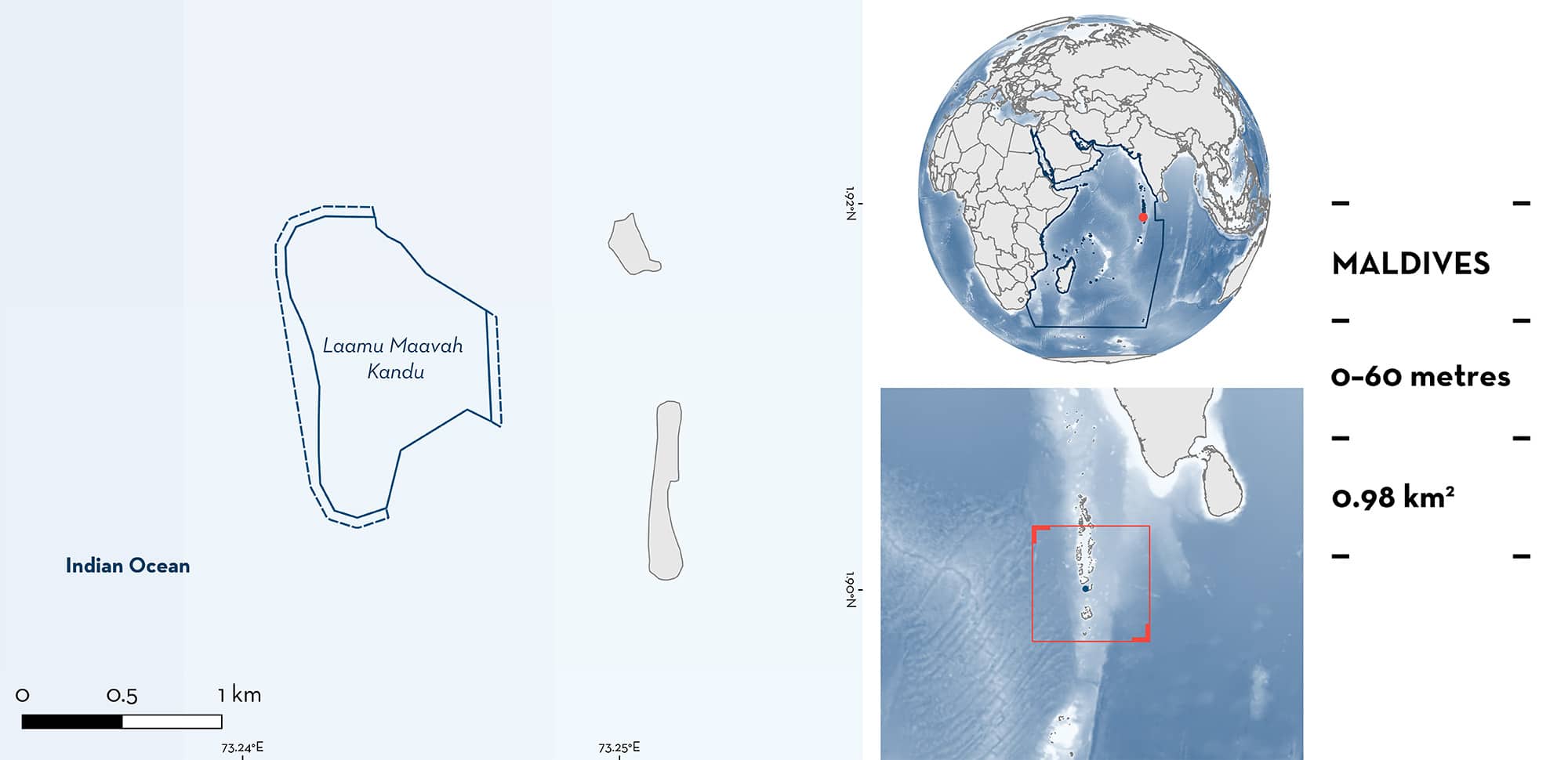ISRA FACTSHEETS
ISRA FACTSHEETS
WESTERN INDIAN OCEAN REGION
Laamu Maavah Kandu
Summary
Laamu Maavah Kandu is a channel entrance located on the western edge of Laamu Atoll in the Maldives. This channel connects the inside of the atoll with the open ocean and is influenced by combined tidal and wind driven currents. This area is also characterised by healthy fringing coral reefs and rocky substrates. Within this area there are: threatened species (e.g., Grey Reef Shark Carcharhinus amblyrhynchos); undefined aggregation (e.g., Silvertip Shark Carcharhinus albimarginatus); and distinctive attributes (Grey Reef Shark).
Download factsheet
Laamu Maavah Kandu
DESCRIPTION OF HABITAT
Laamu Maavah Kandu is located on the western edge of Laamu Atoll, in the southern Maldives (Sluka & Miller 2001). This area encompasses a section of the channel entrance between the islands of Laamu Maavah and Laamu Guraidhoo, and sections of outer reef surrounding the channel including the drop off to the deeper Indian Ocean.
The tides in the Maldives are characterised by a semidiurnal microtidal regime with a tidal range of ~1 m on average (Caldwell et al. 2015; Rasheed et al. 2021). Combined tidal and wind driven currents can exceed speeds of 2 m/s and be variable in speed and direction, especially though the channels between atolls, atoll rims, and channel gaps in the atoll rims (Ciarapica & Passeri 1993; Kuiter & Godfrey 2019; Rasheed et al. 2021). Laamu Atoll is encircled by fringing reefs and has few atoll channels connecting the inner water of the atoll with open ocean resulting in intense currents (Anderson et al. 1992; Sluka & Miller 2001). Currents striking slopes in bottom topography can generate orographic updrafts (Papastamatiou et al. 2021) such as the chanel entrace of Laamu Maavah Kandu.
The habitat of this area is composed of healthy coral reefs, and coral rubble substrate with several large Porites coral blocks rising above the rubble substrate (JM Hodge pers. obs. 2023). These coral blocks function as cleaning stations which provides opportunities for sharks and rays to be cleaned in often high current areas.
This Important Shark and Ray Area is benthopelagic and is delineated from surface waters (0 m) to 60 m based on the observations recorded, the habitat use of the Qualifying Species, and the bathymetry of the area.
CRITERION A
VULNERABILITY
Three Qualifying Species considered threatened with extinction according to the IUCN Red List of Threatened SpeciesTM regularly occur in the area. These are the Endangered Grey Reef Shark (Simpfendorfer et al. 2020) and Spotted Eagle Ray (Finucci et al. submitted), and the Vulnerable Silvertip Shark (Rigby et al. submitted).
CRITERION C
SUB-CRITERION C5 – UNDEFINED AGGREGATIONS
Laamu Maavah Kandu is an important area for undefined aggregations of two sharks and one ray species.
Laamu Atoll has very few reef passes, with the few channels that exist becoming important areas for shark aggregation. Sharks aggregate regularly and predictably in this area during incoming currents which generate updraft zones (Papastamatiou et al. 2021).
Encounter data have been collected by recreational and research divers on 344 surveys between 2017–2023. A total of 6,324 Grey Reef Sharks (average = 18.4 individuals/survey, maximum = 100 individual in one survey), 166 Silvertip Reef Sharks (average = 0.5 individuals/survey, maximum = 20 individuals in one survey), and 2,595 Spotted Eagle Rays (average = 7.5 individuals/survey, maximum = 50 individuals in one survey) have been observed aggregating in this area (Maldives Underwater Initiative by Six Senses Laamu unpubl. data 2023).
Grey Reef Sharks, Silvertip Sharks, and Spotted Eagle Rays are observed cruising in circles at the outer side of the channel entrance. The strong tidal currents at this channel and the nearby drop off to deeper waters may create updraft currents through orographic deflection in which the negatively buoyant Grey Reef Sharks and Silvertip Sharks may be able to rest (e.g., Papastamatiou et al. 2021). Observations have also seen the same behaviour displayed by Spotted Eagle Rays, although the scientific literature on this topic is scarce (Lauder & Di Santo 2015).
This area is of particular significance as it is one of the few sites in Laamu Atoll at which aggregations of this size can be observed. As Laamu has only six channels this highlights the ecological importance of this area, likely linked to the regular and predictable high current incoming tides and the upwelling it creates.
CRITERION D
SUB-CRITERION D1 – DISTINCTIVENESS
Within this area, one shark species shows distinct attributes.
Grey Reef Sharks regularly visit cleaning stations in this area, the cleaning stations lie at depths of around 20 m. Grey Reef Sharks cleaning at this particular section are observed year-round by scuba divers, individually or in groups of up to five individuals (Y Ibrahim pers. obs. 2021; M Staiger pers. obs. 2021–2023; G Holder pers. obs. 2022). The animals at this location display a cleaning behaviour in which they swim at an angle slowly over cleaning stations whilst cleaner wrasse pick off parasites from inside the gills (Y Ibrahim pers. obs. 2021; M Staiger pers. obs. 2021–2023; G Holder pers. obs. 2022). This area is especially relevant as it is one of the only few known cleaning stations for Grey Reef Sharks within Laamu Atoll and the Western Indian Ocean.
Download factsheet
SUBMIT A REQUEST
ISRA SPATIAL LAYER REQUEST
To make a request to download the ISRA Layer in either a GIS compatible Shapefile (.shp) or Google Earth compatible Keyhole Markup Language Zipped file (.kmz) please complete the following form. We will review your request and send the download details to you. We will endeavor to send you the requested files as soon as we can. However, please note that this is not an automated process, and before requests are responded to, they undergo internal review and authorization. As such, requests normally take 5–10 working days to process.
Should you have questions about the data or process, please do not hesitate to contact us.


